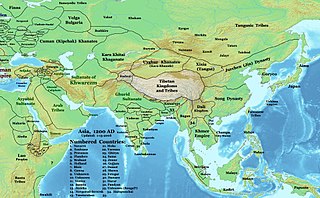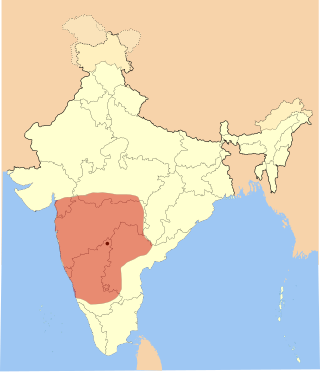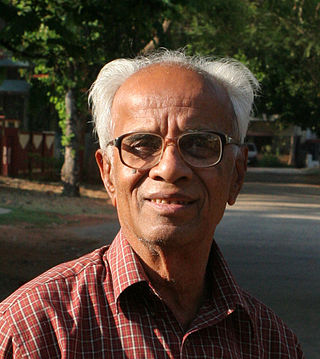
Kannada literature is the corpus of written forms of the Kannada language, a member of the Dravidian family spoken mainly in the Indian state of Karnataka and written in the Kannada script.

Dattātreya Rāmachandra Bēndre, popularly known as Da Rā Bēndre, is generally considered the greatest Kannada lyric poet of the 20th century and one of the greatest poets in the history of Kannada literature. A pioneering poet of Kannada's Navōdaya movement and a leading figure in the linguistic renaissance of Kannada in the region of North Karnataka, Bendre forged a new path in Kannada literature and modern Kannada poetry through his original use of desi Kannada, particularly Dharwad Kannada – the form of Kannada spoken in the North Karnataka region of Dharwad. The richness, originality, and euphony of his poetry, his preternatural feel for the Kannada language, and his charismatic personality would result in him being hailed as a Varakavi by the Kannada people. In a poetic journey that spanned almost 70 years, Bendre engaged continuously in what he called Kāvyōdyōga or 'The High Yoga of Poetry'.

Tigalari, also known as Tulu script, is a Southern Brahmic script which was used to write Tulu, Kannada, and Sanskrit languages. It was primarily used for writing Vedic texts in Sanskrit. It evolved from the Grantha script. It is called as Tigalari lipi in Kannada-speaking regions and Tulu speakers call it as Tulu lipi. It bears high similarity and relationship to its sister script Malayalam, which also evolved from the Grantha script.

North Karnataka is a geographical region in Deccan plateau from 300 to 730 metres elevation that constitutes the region of the Karnataka state in India and the region consists of 13 districts. It is drained by the Krishna River and its tributaries the Bhima, Ghataprabha, Malaprabha, and Tungabhadra. North Karnataka lies within the Deccan thorn scrub forests ecoregion, which extends north into eastern Maharashtra.

Ambale Ramakrishna Krishnashastry (1890–1968) was an Indian writer, researcher and translator in the Kannada language. Krishnashastry has remained popular four decades after his death through his work Vachana Bharata, and his narration of the Hindu epic Mahabharata in the Kannada.

Shunyasampadane is an anthology of poems in the Kannada language that includes the vachanas and dialogues of several Lingayat saints. It is an important part of the holy scriptures of Lingayatism. The word shunyasampadane can be roughly translated as "the acquisition of nothing" in which shunya translates to "nothingness", "void" or "empty". The more precise translation is 'the Graduated Attainment of the Divine Void'. It is part of the important concepts associated with enlightenment in the Indian traditions.

Hoysala literature is the large body of literature in the Kannada and Sanskrit languages produced by the Hoysala Empire (1025–1343) in what is now southern India. The empire was established by Nripa Kama II, came into political prominence during the rule of King Vishnuvardhana (1108–1152), and declined gradually after its defeat by the Khalji dynasty invaders in 1311.

A large body of Western Chalukya literature in the Kannada language was produced during the reign of the Western Chalukya Empire in what is now southern India. This dynasty, which ruled most of the western Deccan in South India, is sometimes called the Kalyani Chalukya Dynasty after its royal capital at Kalyani, and sometimes called the Later Chalukya Dynasty for its theoretical relationship to the 6th-century Chalukya dynasty of Badami. For a brief period (1162–1183), the Kalachuris of Kalyani, a dynasty of kings who had earlier migrated to the Karnataka region from central India and served as vassals for several generations, exploited the growing weakness of their overlords and annexed the Kalyani. Around 1183, the last Chalukya scion, Someshvara IV, overthrew the Kalachuris to regain control of the royal city. But his efforts were in vain, as other prominent Chalukya vassals in the Deccan, the Hoysalas, the Kakatiyas and the Seunas destroyed the remnants of the Chalukya power.

Vachana sahitya is a form of rhythmic writing in Kannada that evolved in the 11th century and flourished in the 12th century, as a part of the Sharana movement. Madara Chennaiah, an 11th-century cobbler-saint who lived during the reign of the Western Chalukyas is regarded by some scholars as the "father of Vachana poetry". The word "vachanas" literally means "(that which is) said". These are readily intelligible prose texts.

Theerthapura Nanjundaiah Srikantaiah commonly known as 'Thee. Nam. Shree., was a Kannada poet, essayist, editor, translator, linguist and teacher. He was awarded the Pampa Prashasthi for his work on the history and tradition of Indian poetics spanning two millennia titled Bharathiya Kavyamimamse. T. N. Srikantaiah was instrumental in preparing and publishing the Kannada version of Constitution of India in 1952. He is credited with the use of the vernacular equivalent of Rashtrapathi for the English 'President', a usage which is still in vogue. Srikantaiah was responsible for guiding the doctoral theses of Kannada litterateurs like S. Anantanarayan and M. Chidananda Murthy. An active participant in the Kannada Dictionary Project, Srikantaiah later laid the foundations for the Post Graduate Department at Manasa Gangotri campus at University of Mysore.
Medieval Kannada literature covered a wide range of subjects and genres which can broadly be classified under the Jain, Virashaiva, Vaishnava and secular traditions. These include writings from the 7th century rise of the Badami Chalukya empire to the 16th century, coinciding with the decline of Vijayanagara Empire. The earliest known literary works until about the 12th century CE were mostly authored by the Jainas along with a few works by Virashaivas and Brahmins and hence this period is called the age of Jain literature,. The 13th century CE, to the 15th century CE, saw the emergence of numerous Virashaiva and Brahminical writers with a proportional decline in Jain literary works. Thereafter, Virashaiva and Brahmin writers have dominated the Kannada literary tradition. Some of the earliest metres used by Jain writers prior to 9th century include the chattana, bedande and the melvadu metres, writings in which have not been discovered but are known from references made to them in later centuries. Popular metres from the 9th century onwards when Kannada literature is available are the champu-kavyas or just champu, vachanasangatya, shatpadi, ragale, tripadi, and kavya.

Malleshappa Madivalappa Kalburgi was an Indian scholar of Vachana sahitya in the Kannada-language and academic who served as the vice-chancellor of Kannada University in Hampi. A noted epigraphist of Kannada, he was awarded the National Sahitya Akademi Award in 2006 for Marga 4, a collection of his research articles.
Lingappa Basavaraju, commonly known as L. Basavaraju or LB, was an Indian scholar, writer, critic and researcher in Kannada. He was the author of over 56 works and his contribution to Kannada literature spread over 40 years.
R. C. Hiremath was a professor of Kannada and the Vice-Chancellor of Karnataka University, Dharwar after A. S. Adke. Hiremath was the president of the 59th Kannada Sahitya Sammelana. He was a founding member the Dravidian Linguistics Association and the director of International School of Dravidian Linguistics (ISDL) in Trivandrum. His work ranges from creative and critical work to several editorial publications.

Sarvajña was a Kannada poet, pragmatist and philosopher of the 16th century. The word "Sarvajna" in Sanskrit literally means "the all knowing". His father was Kumbara Malla and his mother was Mallaladevi. His birth anniversary is celebrated on February 20 every year. He belongs to the caste of Kumbara. He is famous for his pithy three-lined poems called tripadi. He is also referred as Sarvagna in modern translation.

Mandagere Subbarao Krishnamurthy, known by the pen name Indiresh or Ma Su Krishnamurthy, is a Kannada writer and Hindi writer.
Professor Armando Menezes (1902–1983) was an Indian civil servant, writer, academic and poet who wrote in English.

B.S Sannaiah was an Indian writer in Kannada language. He was born in Bhoganahalli, Piriyapatna talluk, Mysore, Karnataka. He worked as a Editor, Textual critic and a follower and protector of ancient Archaic works & manuscripts. He had undertaken study and research in various manuscript works in Kannada & jain literature and made some of the major contributions in the field.

Taľaku Subbanna Venkannayya was University of Mysore's first Kannada Professor. He was also a popular Kannada writer, translator, editor and teacher who nurtured many later Kannada littérateurs like Kuvempu, D. L. Narasimhachar, T. N. Srikantaiah, K. S. Narasimhaswamy, M. V. Seetharamaiah, C. K. Venkataramaiah, K. Venkataramappa, G. Venkatasubbiah and S. V. Parameshwara Bhatta. In fact, Kuvempu begins his book Sri Ramayana Darshanam with a two-page dedication to his teacher T. S. Venkannayya. T. S. Venkannayya translated the biography of Ramakrishna Paramahamsa from Bengali into Kannada for the first time in 1919. T. S. Venkannayya along with D. V. Gundappa, V. Seetharamaiah, B. M. Srikantaiah and T. N. Srikantaiah were at the forefront of the Kannada Movement from 1920s onwards and were instrumental in the founding of Kannada Sahitya Parishat (Bangalore) and Kannada Sangha at Central College, Bangalore and Maharaja College, Mysore. T. S. Venkannayya was responsible for the organising of the 1931 Kannada Sahitya Sammelan at Mysore.













